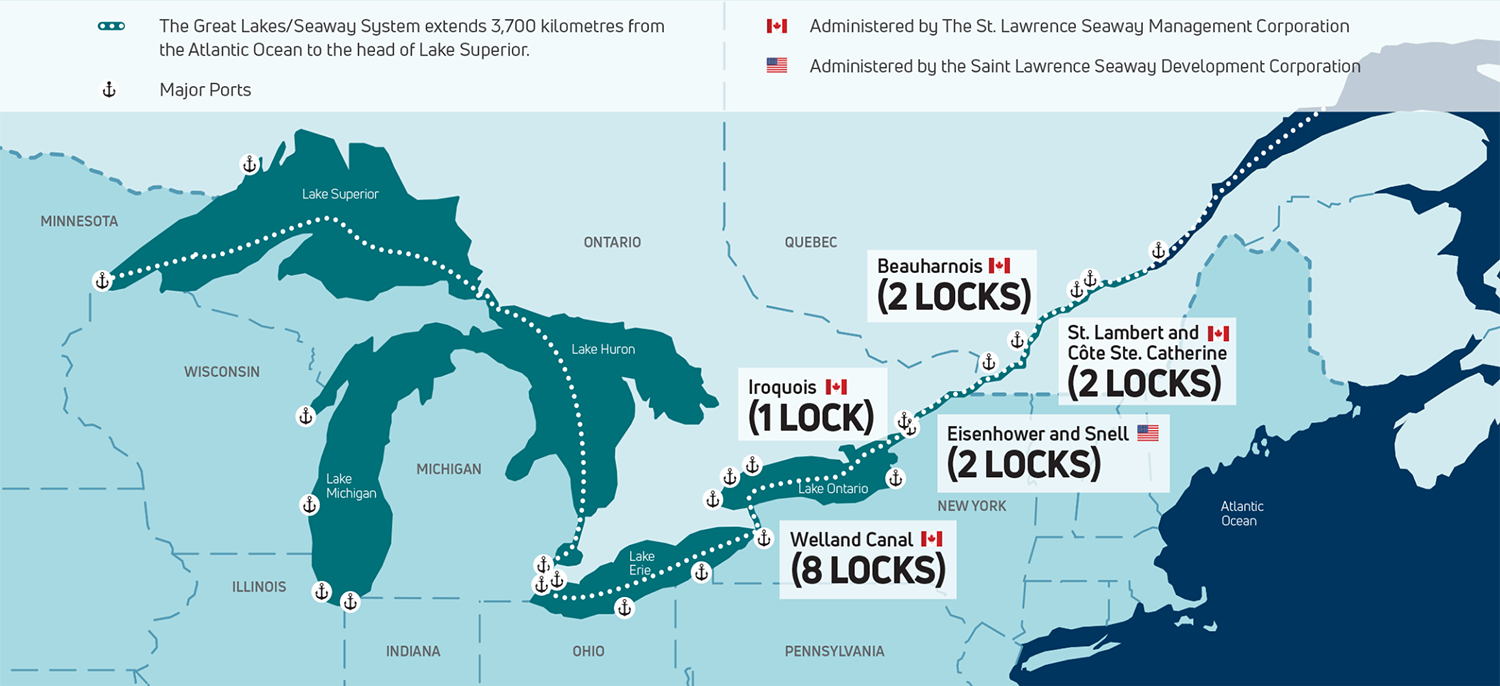Strike by Canadian Seaway workers shuts down binational waterway

Some 361 workers in Ontario and Quebec began a strike on Sunday at 00.01 am after negotiations failed to meet a union-imposed deadline with Canada’s St. Lawrence Seaway Management Corporation (SLSMC). The first such work stoppage since 1968 on the bi-national waterway and important supply chain corridor stirred a big cry of alarm not only from Canadian marine industry and business circles but also from U.S. Great Lakes ports urging Canada’s federal government to intervene.
Established in 1959, the St. Lawrence Seaway represents a vital connection between the Atlantic Ocean and the industrial heartland of North America through a series of 15 locks – of which 13 Are Canadian and two American (at Massena, NY). The only previous strike launched in June 1968 idled 300 vessels for 24 days.
According to the SLSMC, currently there are no vessels waiting to exit the system, but there are over 100 vessels outside the system, which are impacted by the situation.
On Friday, the American Great Lakes Ports Association sent a letter urging Canada’s Minister of Transport, Pablo Rodriguez, and Labor Minister Seamus O’Reagan to help resolve the conflict and prevent a disruption to commerce that would have “disastrous impacts.”
“Seaway commerce serves important sectors of the North American economy, including steel making, energy, agriculture, construction, and manufacturing,” noted AGLPA Executive Director Steve Fisher in a letter to the two Canadian ministers. “A recent economic impact analysis of commerce through the Seaway documents that in 2022 the waterway handled more than 36 2 million tons of cargo and supported more than 24,000 jobs in the United States and 42,000 in Canada.
“A 2020 analysis of mid-season closure scenarios shows that a two-week closure would result in the loss of 19,227 jobs; a five-week closure would result in the loss of 21,046 jobs; and an 8- week closure would result in the loss of 22,144 jobs.

“Beyond the immediate economic impacts, we fear the looming work stoppage will damage the record of reliability that users of the system have come to depend upon. As an inland transportation system, the Seaway competes with other modes of transportation such as rail and trucking. Further, the Seaway system competes with the U.S. inland river barge system. In these ways, supply chain managers have options, and they will make transport decisions based on cost and reliability,” the AGLPA said.
The Canadian Chamber of Commerce and the Canadian Federation of Independent Business are among industry groups in Canada that quickly issued statements. While respecting the right to collective bargaining, they said “Canada’s economy and our supply chains cannot afford another strike” – referring to a 13-day docker strike on Canada’s west coast last July.
“The parties are at an impasse as UNIFOR (union representing Canadian Seaway workers) continues to insist on wage increases inspired by automotive-type negotiations, while the SLSMC works to find a fair and competitive labour agreement that balances wage demands and market realities, “ the SLSDMC said today.
As a result, the system will remain shut down until an agreement can be reached, whether it be temporary or tentative, as we work diligently to minimize disruption for all stakeholders. The existing collective agreement expired on March 31, 2023.
Stakes are high
“The stakes are high, and we are fully dedicated to finding a resolution that serves the interests of the Corporation and its employees. We remain committed to continuing discussions and reaching a fair labour agreement,” stated Terence Bowles, SLSMC President and CEO. “In these economically and geopolitically critical times, it is important that the Seaway remains a reliable transportation route for the efficient movement of essential cargoes between North America and the remainder of the world.”
The SLSMC is awaiting a response to its Canada Industrial Relations Board application, seeking a ruling under the Canada Labour Code for the Union to provide employees during a strike to ensure vessels engaged in the movement of grain continue transiting the system.
An orderly shutdown of the system took place during the 72-hour notice period allowing for vessels to safely clear the Seaway system, and the Corporation remains in regular contact with the marine industry.
The SLSMC is awaiting a response to its Canada Industrial Relations Board application, seeking approval as allowed under the Canada Labour Code for ships engaged in the movement of grain to continue transiting the system during the work stoppage.
Unifor National President Lana Payne expressed her disappointment in the failure of the employer to make serious movement in the past two days, saying: "This impasse is extremely unfortunate but our members remain committed to getting a fair agreement."
Unifor Quebec Director Daniel Cloutier emphasized the negotiating committee's ongoing commitment to constructive dialogue and said, "We negotiated in good faith right up to the last moment, but we cannot allow workers' rights to be compromised. We remain open to discussion and hope that the employer will reconsider its position for the good of all."
© Copyright 1999–2024 American Journal of Transportation. All Rights Reserved

